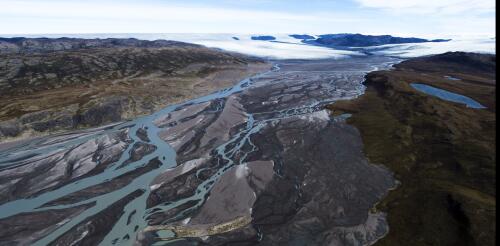Ice Age
As we focused our microscope on the soil sample for the first time, bits of organic material came into view: a tiny poppy seed, the compound eye of an insect, broken willow twigs and spikemoss spores. Dark-colored spheres produced by soil fungi dominated our view. These were unmistakably the remains of an arctic tundra ecosystem – and proof that Greenland’s entire ice sheet disappeared more recently than people realize. These tiny hints of past life came from a most unlikely place – a handful of soil that had been buried under 2 miles of ice below the summit of the Greenland ice sheet. Projections of future melting of the ice sheet are unambiguous: When the ice is gone at the summit, at least 90% of Greenland’s ice will have melted. Results of an ice sheet model show how much of Greenland’s ice sheet survives when the ice is gone from the Camp Century (white dot), GISP2 (red dot) and DYE-3 (black dot) ice...
About 400,000 years ago, large parts of Greenland were ice-free. Scrubby tundra basked in the Sun’s rays on the island’s northwest highlands. Evidence suggests that a forest of spruce trees, buzzing with insects, covered the southern part of Greenland. Global sea level was much higher then, between 20 and 40 feet above today’s levels. Around the world, land that today is home to hundreds of millions of people was under water. Scientists have known for awhile that the Greenland ice sheet had mostly disappeared at some point in the past million years, but not precisely when. In a new study in the journal Science, we determined the date, using frozen soil extracted during the Cold War from beneath a nearly mile-thick section of the Greenland ice sheet. A brief look at the evidence beneath Greenland’s ice sheet and the lessons its holds. The timing – about 416,000 years ago, with largely ice-free conditions last...
As scorching heat grips large swaths of the Earth, a lot of people are trying to put the extreme temperatures into context and asking: When was it ever this hot before? Globally, 2023 has seen some of the hottest days in modern measurements, but what about farther back, before weather stations and satellites? Some news outlets have reported that daily temperatures hit a 100,000-year high. As a paleoclimate scientist who studies temperatures of the past, I see where this claim comes from, but I cringe at the inexact headlines. While this claim may well be correct, there are no detailed temperature records extending back 100,000 years, so we don’t know for sure. Here’s what we can confidently say about when Earth was last this hot. This is a new climate state Scientists concluded a few years ago that Earth had entered a new climate state not seen in more than 100,000 years. As fellow climate scientist Nick McKay and I recently discussed in a scientific journal art...


